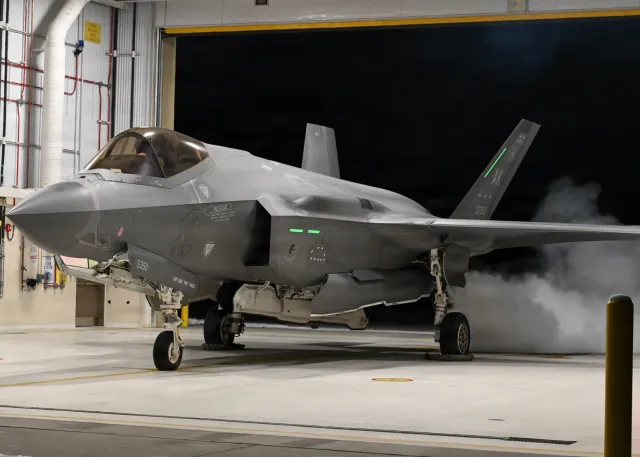Alaska
Solo climber dies in fall on Alaska’s Denali — highest peak in North America

A solo climber was found dead Monday as he attempted to scale Denali in Alaska — the highest mountain peak in North America, federal officials said.
The body of Japanese hiker T. Hagiwara was discovered 17,000 feet up the massive mountain on the West Buttress route by National Park Service rangers after he apparently fell during the climb.
A concerned family member called authorities when they hadn’t heard from their loved one who had been checking in with an InReach satellite communicator, the National Park Service said.
The Denali National Park and Preserve rangers overseeing the upper mountain quickly found Hagiwara’s empty tent at the top of a 16,200-foot ridge.
Through interviews with other climbers the rangers determined Hagiwara, of Sapporo, Hokkaido, was last seen ascending from a 17,200 plateau to the Denali Pass at 18,200 feet last Wednesday.
Rescuers also tapped into the climber’s InReach data that showed the device had not changed location since last Thursday, which led them to believe he fell from the Denali Pass the same day, the National Park Service said.
After rough weather cleared up, a spotting scope was used to locate the climber, who was confirmed dead when patrols reached the body.
His body was retrieved Monday evening.
Only the first initial of Hagiwara’s first name was released in line with his family’s wishes, a park spokesperson said.
The deceased climber is one of at least 14 climbers that have died in falls from dangerous parts of the West Buttress route, park officials said.
With Post wires

Alaska
Opinion: A new energy project, new risks and new responsibilities for Alaska
Alaska may soon face major decisions about the future of the Alaska LNG project and, if so, the Legislature will need to ensure that every step serves the best interests of Alaskans.
It is essential to remember that Senate Bill 138, the blueprint for state involvement in Alaska LNG, was passed in 2014 for a very different project: one led by ExxonMobil, BP and ConocoPhillips, with a key role fulfilled by TransCanada. Today’s project is led by a private-equity developer, Glenfarne, pursuing a structure that diverges dramatically from what lawmakers contemplated more than a decade ago. When a project changes this much, the underlying statutes need to be revisited.
In June, the Alaska Gasline Development Corp.’s president told his board that AGDC would be coordinating with the developer, the administration and the Legislature regarding legislation needed to support project development. He also noted that AGDC would work with the administration and Legislature on policies required to exercise the corporation’s option to invest 5% to 25% equity at Final Investment Decision, or FID. When AGDC itself signals that legislation is necessary, we should look forward to their outreach.
SB 138 also assigned important responsibilities to the departments of revenue and natural resources that may require legislative action. One key responsibility is the Legislature’s authority to approve major gas project contracts negotiated by the DNR commissioner. The law clearly states that balancing, marketing and gas sale agreements for North Slope gas cannot take effect without explicit legislative authorization. That statutory requirement was intentional and recognizes a project of this scale demands legislative oversight.
We also know that the pressure for speed on complex megaprojects often backfires, sometimes creating more problems than it solves. The Legislature must balance the legitimate need for progress with the responsibility to ensure Alaskans are not asked to assume unreasonable financial risk. As Speaker Bryce Edgmon recently observed, legislation of this magnitude “could dominate the session” and “take significant time.” Senate Finance Co-Chair Bert Stedman was even more direct: if we get this wrong, it could be “detrimental for generations.”
Last week, 4,000 miles away in Washington, D.C., Glenfarne and POSCO International announced a major strategic partnership. It is a meaningful milestone. But Alaska has seen similar announcements before, and it does not diminish the need for hard questions. If anything, it raises them.
Final Investment Decision is when investors and lenders commit billions based on the project’s economics and the state’s fiscal terms. Any legislation affecting property taxes, payments-in-lieu-of-taxes, aka PILTs, state equity, fiscal stability, or upstream royalties and production taxes must be decided before this takes place.
The Legislative Budget and Audit Committee has focused on providing lawmakers and the public with the information needed to understand the choices ahead. I revisited the Legislature’s 2014 “Alaska LNG: Key Issues” report, which helped lawmakers evaluate the original SB 138 framework. Building on that model, I directed our consultants, GaffneyCline, to prepare an updated “key issues” report; not to endorse or oppose the current project, but to provide a high-level overview of potential policy choices, which should be available to the public within the next few days.
The refreshed “key issues” report will be an important starting point. I ask Alaskans to approach it with an open mind and to read it as objectively as possible, free from assumptions shaped by past disappointments or early optimism. Keep asking tough questions of the Legislature, AGDC, Glenfarne and the administration. Don’t assume the project is a done deal or a doomed one. This is not about cheerleading or obstruction, but insisting on rigorous analysis, strong oversight and a fair deal for our children and grandchildren.
Some Alaskans have raised questions about a potential conflict of interest: GaffneyCline is a subsidiary of Baker Hughes, which recently announced agreements with Glenfarne to help advance the Alaska LNG project. I share those concerns, which is why I have met with the Legislature’s director of Legal Services and with GaffneyCline’s North America director. I have been assured by GaffneyCline’s leadership that no one outside the GaffneyCline project team has influenced their analysis, and that their global reputation for independence and trust remains intact. Still, we also must fully vet this issue when we convene in Juneau next month. Transparency and independence are non-negotiable.
The recent ceremony in Washington, D.C., with Glenfarne and POSCO International underscores the project’s potential; however, the authority to determine how and when Alaska monetizes its resources rests here, not with dignitaries celebrating overseas commitments. Our future will be determined in Alaska, by Alaskans, based on the fullest and most honest understanding of the choices before us.
Sen. Elvi Gray-Jackson, D-Anchorage, represents Senate District G, which includes Midtown, Spenard and Taku Campbell in Anchorage. Sen. Gray-Jackson serves as the chair of the Legislative Budget and Audit Committee.
• • •
The Anchorage Daily News welcomes a broad range of viewpoints. To submit a piece for consideration, email commentary(at)adn.com. Send submissions shorter than 200 words to letters@adn.com or click here to submit via any web browser. Read our full guidelines for letters and commentaries here.
Alaska
Trump Repeals Biden Land Protections in Alaska, Other States

Alaska
Alaska Hosts US Bomber Exercise Against ‘Threats to the Homeland’

The United States deployed two bombers to simulate strikes against “maritime threats” to the homeland in response to a growing Russian and Chinese presence near Alaska.
Newsweek has contacted China’s Foreign Ministry for comment by email. Russia’s defense and foreign ministries did not immediately respond to a request for comment.
Why It Matters
Russia and China have closely cooperated in military matters under their “partnership without limits,” including a joint naval maneuver in the north Pacific near Alaska’s Aleutian Islands involving 11 Russian and Chinese vessels in summer 2023.
Facing a growing Moscow-Beijing military partnership, along with increased Chinese activities in the Arctic, the U.S. has been reinforcing its military presence in Alaska by deploying warships and conducting war games with its northern neighbor, Canada.
Bombers, capable of flying long distances and carrying large amounts of armaments, are a key instrument for the U.S. military to signal its strength. The American bomber force has recently conducted operations as a show of force aimed at Russia and China.
What To Know
According to a news release, the Alaskan Command executed simulated joint maritime strikes with Air Force B-52H bombers and the Coast Guard national security cutter USCGC Kimball in the Gulf of Alaska on Tuesday as part of Operation Tundra Merlin.
The bombers are assigned to the 2nd Bomb Wing out of Barksdale Air Force Base in Louisiana, while the Kimball is homeported in Honolulu. The 354th Fighter Wing at Eielson Air Force Base in Alaska also deployed four F-35A stealth fighters.
Other supporting units included two KC-135 aerial refueling aircraft and an HC-130 aircraft on standby to conduct personnel recovery missions, the news release said.
During the operation, the bombers received target information from the Kimball for standoff target acquisition and simulated weapons use, while the F-35A jets—tasked with escorting the bombers—enhanced mission security and operational effectiveness.
According to an Air Force fact sheet, each B-52H bomber has a maximum payload of 70,000 pounds and is capable of carrying up to 20 standoff weapons—designed to be fired from outside enemy defenses—such as the Joint Air-to-Surface Standoff Missile.
The simulated strikes “demonstrated the capability of the [U.S. Northern Command] and its mission partners to deter maritime threats to the homeland,” the news release said.
Homeland defense is the Alaskan Command’s top priority, said its commander, U.S. Air Force Lieutenant General Robert Davis, adding that the ability to integrate with other commands and partners is key to safeguarding the U.S. northern approaches.

What People Are Saying
U.S. Air Force Lieutenant General Robert Davis, the commander of the Alaskan Command, said: “Operations in the Alaskan Theater of Operations are critically important to North American Homeland Defense. Operation Tundra Merlin demonstrates the Joint Force’s ability to seamlessly integrate capabilities from multiple combatant commands and mission partners to deter and defeat potential threats in the region.”
The Alaskan Command said: “Operation Tundra Merlin is a Homeland Defense focused joint operation designed to ensure the defense of U.S. territory and waters within the Alaskan Theater of Operations (AKTO). The operation includes integration with partners in the region with the shared goal of North American defense in the Western Arctic.”
What Happens Next
It remains to be seen whether Russia and China will conduct another joint air patrol near Alaska following a similar operation over the western Pacific earlier this week.
-

 Alaska6 days ago
Alaska6 days agoHowling Mat-Su winds leave thousands without power
-
Ohio1 week ago
Who do the Ohio State Buckeyes hire as the next offensive coordinator?
-

 Texas6 days ago
Texas6 days agoTexas Tech football vs BYU live updates, start time, TV channel for Big 12 title
-

 Washington3 days ago
Washington3 days agoLIVE UPDATES: Mudslide, road closures across Western Washington
-

 Iowa5 days ago
Iowa5 days agoMatt Campbell reportedly bringing longtime Iowa State staffer to Penn State as 1st hire
-

 Miami, FL6 days ago
Miami, FL6 days agoUrban Meyer, Brady Quinn get in heated exchange during Alabama, Notre Dame, Miami CFP discussion
-

 Cleveland, OH5 days ago
Cleveland, OH5 days agoMan shot, killed at downtown Cleveland nightclub: EMS
-
World5 days ago
Chiefs’ offensive line woes deepen as Wanya Morris exits with knee injury against Texans


























